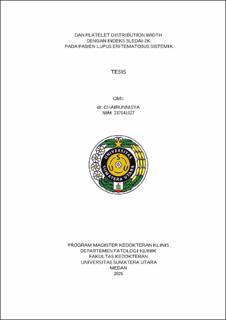Hubungan Antara Nilai Mean Platelet Volume Dan Platelet Distribution Width Dengan Indeks Sledai-2K Pada Pasien Lupus Eritematosus Sistemik
Relationship between Mean Platelet Volume and Platelet Distribution Width Values with the Sledai-2K Index in Systemic Lupus Erythematosus Patients

Date
2025Author
Chairunnisya, Chairunnisya
Advisor(s)
Loesnihari, Ricke
Ginting, Almaycano
Metadata
Show full item recordAbstract
Background: Systemic Lupus Erythematosus (SLE) is a chronic autoimmune disease with a wide range of clinical manifestations and is characterized by alternating phases of remission and flare-ups. Platelets and their indices play an important role in the inflammatory response and immunological reactions. Mean Platelet Volume (MPV) and Platelet Distribution Width (PDW) are simple hematological parameters included in platelet indices, suspected to be associated with disease activity, and have been proposed as biomarkers of disease activity.
Objective: This study aimed to evaluate the relationship between MPV and PDW values and the SLEDAI-2K Index in patients with Systemic Lupus Erythematosus.
Methods: This was an analytical study with a cross-sectional design conducted at Adam Malik Hospital, Medan, from February to April 2025, was conducted after obtaining ethical approval and informed consent. A total of 66 SLE patients were selected using consecutive sampling and divided equally into two groups: flare and non-flare. Data were analyzed using univariate analysis, bivariate (Spearman correlation test, p < 0.05 due to non-normal data distribution), and multivariate (multiple logistic regression) analysis.
Results and Discussion: The majority of subjects were female (95.5%) with a mean age of approximately 31 years. The flare group showed lower MPV and PDW values compared to the non-flare group. A significant negative correlation was found between MPV and the SLEDAI-2K index (r = -0.424; p < 0.001), as well as between PDW and SLEDAI-2K (r = -0.429; p < 0.001). Multivariate analysis using logistic regression showed that MPV was the only independent variable significantly associated with SLE flare (OR = 0.340; p = 0.002), whereas PDW did not show a meaningful association (p = 0.858).
Conclusion and Recommendation: MPV and PDW show potential as indicators of disease activity in SLE. MPV is proven to be a strong independent predictor of SLE flare activity, whereas PDW is not. Lower MPV values are associated with increased disease activity and may serve as a simple hematological marker for predicting flares in SLE.
